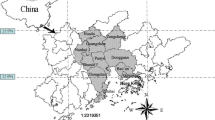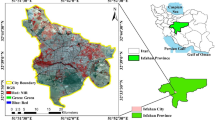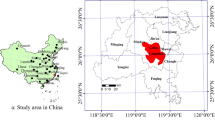Abstract
In recent years, environmental issues such as global warming and climate change have led to an increased focus on finding solutions to reduce its impacts, especially in urban areas. Remote sensing data have become an increasingly popular tool for conducting environmental assessment studies. The objective of this study was to assess and analyze the ecological environmental quality of Karaj County using Landsat satellite imagery of 2010 and 2020. In addition, the spatial pattern of landscape metrics has been quantified to assess the spatial pattern of green spaces. The greenness, moisture, dryness, and heat indicators were combined into a comprehensive RSEI index. The importance of the sub-indicators was determined using principal component analysis and weighted to obtain the RSEI index, which consists of the components LST, NDVI, NDBI, and wetness. The results indicate that the overall quality of the ecological environment in Karaj district has decreased, with the mean RSEI decreasing from 0.59 to 0.25. Landscape characteristics of the ecological environment have changed to a more separated, incoherent, and irregular pattern. Specifically, RSEI values had a significant correlation with landscape pattern change. The value of the COHESION metric has decreased and the value of the Edge Density has increased, which indicates the separation of the green space in the study area. These results could be valuable information for decision makers in managing or achieving an optimal eco-environment landscape pattern in urbanized areas.






Similar content being viewed by others
Data availability
All data generated or analysed during this study are included in this published article.
References
Abdi Z, Gholami M, Reza’ei R, Tavana L (2018) Sustainable development and expansion of Green Regions in Karaj and its suburbs using GIS software. J Biochem Tech 2018(Special Issue 2):34–43
Abdullah HM, Akiyama T, Shibayama M, Awaya Y (2011) Estimation and validation of biomass of a mountainous agroecosystem by means of sampling, spectral data and QuickBird satellite image. Int J Sust Dev World 18(5):384–392. https://doi.org/10.1080/13504509.2011.562002
Alaei N, Mostafazadeh R, Esmali Ouri A, Hazbavi Z, Sharari M (2022) Spatial comparative analysis of landscape fragmentation metrics in a watershed with diverse land uses in Iran. Sustainability 14:14876
Asadi Y, Ezimand K, Keshtkar H (2019) A survey of landscape metrics and land-use/land-cover structures on urban heat islands surface: a case study on Urmia City. Iran Desert 24(2):205–208
Amorim JGA, Schreiber LV, de Souza MRQ, Negreiros M, Susin A, Bredemeier C, Parraga A (2022) Biomass estimation of spring wheat with machine learning methods using UAV-based multispectral imaging. Int J Remote Sens 43(13):4758–4773
Baig MHA, Zhang L, Shuai T, Tong Q (2014) Derivation of a tasseled cap transformation based on Landsat 8 at-satellite reflectance. Remote Sens Lett 5(5):423–431
Bertolo LS, Lima GT, Santos NP (2012) Identifying change trajectories and evolutive phases on coastal landscapes. Case study: São Sebastião Island, Brazil. Landsc Urban Plann 106(1):115–123
Boongaling C, Faustino-Eslava G K, Lansigan DV (2018) Modeling land use change impacts on hydrology and the use of landscape metrics as tools for watershed management: the case of an ungauged catchment in the Philippines. Land Use Policy 72:116–128
Brehaut L, Danby RK (2018) Inconsistent relationships between annual tree ring-widths and satellite-measured NDVI in a mountainous subarctic environment. Ecol Ind 91:698–711
Chakraborty T, Lee X (2019) A simplified urban-extent algorithm to characterize surface urban heat islands on a global scale and examine vegetation control on their spatiotemporal variability. Int J Appl Earth Obs Geoinf 74:269–280
Chen J, Shen M, Zhu X, Tang Y (2009) Indicator of flower status derived from in situ hyperspectral measurement in an alpine meadow on the Tibetan Plateau. Ecol Ind 9(4):818–823
Chen A, Yao L, Sun R, Chen L (2014) How many metrics are required to identify the effects of the landscape pattern on land surface temperature? Ecol Ind 45:424–433
Coutts AM, Harris RJ, Phan T, Livesley SJ, Williams NSG, Tapper NJ (2016) Thermal infrared remote sensing of urban heat: hotspots, vegetation, and an assessment of techniques for use in urban planning. Remote Sens Environ 186:637–651
Crist EP (1985) A TM tasseled cap equivalent transformation for reflectance factor data. Remote Sens Environ 17(3):301–306
Dadashpoor H, Azizi P, Moghadasi M (2019) Land use change, urbanization, and change in landscape pattern in a metropolitan area. Sci Total Environ 655:707–719
Echeverría C, Newton A, Nahuelhual L, Coomes D, Rey-Benayas JM (2012) How landscapes change: integration of spatial patterns and human processes in temperate landscapes of southern Chile. Appl Geogr 32(2):822–831
Ellis EC, Wang HQ, Xiao HS, Peng K, Liu XP, Lie SC, Ouyang H, Cheng X, Yang LZ (2006) Measuring long-term ecological changes in densely populated landscapes using current and historical high-resolution imagery. Remote Sens Environ 100(4):457–454
Esfandiyari Darabad F, Hamzeei M, Alaei N, Mostafazadeh R (2021) Spatial variations of landscape metrics in riparian area vegetation of Gharesou River reaches under the effect of different land uses, Ardabil Province. Geographical Plann Space 10(38):219–234 ((In Persian))
Fan C, Myint S (2014) A comparison of spatial autocorrelation indices and landscape metrics in measuring urban landscape fragmentation. Landsc Urban Plann 121:117–128
Gillanders SN, Coops NC, Wulder MA, Gergel SE, Nelson T (2008) Multitemporal remote sensing of landscape dynamics and pattern change: describing natural and anthropogenic trends. Prog Phys Geogr 32(5):503–528
Guo H, Zhang B, Bai Y, He X (2017) Ecological environment assessment based on remote sensing in Zhengzhou. IOP Conf Series: Earth Environ Sci 94:012190. https://doi.org/10.1088/1755-1315/94/1/012190
Hao R, Yu D, Liu Y, Liu Y, Qiao J, Wang X, Du J (2017) Impacts of changes in climate and landscape pattern on ecosystem services. Sci Total Environ 579:718–728
Hao H, Lian Z, Zhao J, Wang H, He Z (2022) A remote-sensing ecological index approach for restoration assessment of rare-earth elements mining. Comput Intell Neurosci 2022. https://doi.org/10.1155/2022/5335419
Heydarzadeh H, Danehkar A (2016) Green space management strategies in Karaj Region 2. Environ Researches 6(12):159–172
Hu X, Xu H (2018) A new remote sensing index for assessing the spatial heterogeneity in urban ecological quality: a case from Fuzhou City, China. Ecol Ind 89:11–21
Ivits E, Cherlet M, Mehl W, Sommer S (2009) Estimating the ecological status and change of riparian zones in Andalusia assessed by multi-temporal AVHHR datasets. Ecol Ind 9(3):422–431
Jabbarian Amiri B, Dezhkam SS (2020) Investigating the relationship between land surface temperature and landscape spatial pattern by using regression models and landscape metrics. J Nat Environ 73(2):285–298
Kang H, Tao W, Chang Y, Zhang Y, Xuxiang L, Chen P (2018) A feasible method for the division of ecological vulnerability and its driving forces in Southern Shaanxi. J Clean Prod 205:619–628
Kennedy RE, Andréfouët S, Cohen WB, Gómez C, Griffiths P, Hais M, Zhu Z (2014) Bringing an ecological view of change to Landsat-based remote sensing. Front Ecol Environ 12(6):339–346
Kurda KP (2022) The urban ecosystem services index as a new indicator for sustainable urban planning and human well-being in cities. Ecol Ind 144:109532
Lausch A, Blaschke T, Haase D, Herzog F, Syrbe RU, Tischendorf L, Walz U (2015) Understanding and quantifying landscape structure–a review on relevant process characteristics, data models and landscape metrics. Ecol Model 295:31–41
Li X, Li Y, Zhang S, Lin R, Chen M, Feng L (2023) Driving effects of land use and landscape pattern on different spontaneous plant life forms along urban river corridors in a fast-growing city. Sci Total Environ 876:162775
Marzban F, Sodoudi S, Preusker R (2018) The influence of land-cover type on the relationship between NDVI–LST and LST-T air. Int J Remote Sens 39(5):1377–1398
McGarigal K, Cushman SA, Ene E (2012) Spatial pattern analysis program for categorical and continuous maps. Computer software program produced by the authors at the University of Massachusetts, Amherst. FRAGSTATS v4. See http://www.umass.edu/landeco/research/fragstats/fragstats.html. Accessed 19 Oct 2015
Meng D, Yang S, Gong H, Li X, Zhang J (2016) Assessment of thermal environment landscape over five megacities in China based on Landsat 8. J Appl Remote Sens 10(2):026034–026034
Meng Q, Zhang L, Sun Z, Meng F, Wang L, Sun Y (2018) Characterizing spatial and temporal trends of surface urban heat island effect in an urban main built-up area: a 12-year case study in Beijing, China. Remote Sens Environ 204:826–837
Mostafazadeh R, Talebi Khiavi H (2022) Landscape change assessment and its prediction in a mountainous gradient with diverse land-uses. Environ Dev Sustain 1–31. https://doi.org/10.1007/s10668-022-02862-x
Nazarneghad H, Hosseine M, Mostafazadeh R (2020) Assessment of changes in Landuse connectivity and pattern using landscape metrics in the Zolachai Watershed, Salmas. Geographical Plann Space 9(34):53–66 ((In Persian))
Nichol J (2009) An emissivity modulation method for spatial enhancement of thermal satellite images in urban heat island analysis. Photogrammetric Eng Remote Sens 75(5):547–556
Ochoa-Gaona S, Kampichler C, De Jong BHJ, Hernández S, Geissen V, Huerta E (2010) A multi-criterion index for the evaluation of local tropical forest conditions in Mexico. For Ecol Manag 260(5):618–627
Ouyang ZY, Wang Q, Zheng H, Zhang F, Hou P (2014) National ecosystem survey and assessment of China (2000–2010). Bull Chin Acad Sci 29(4):462–466
Pettorelli N, Vik JO, Mysterud A, Gaillard JM, Tucker CJ, Stenseth NC (2005) Using the satellite-derived NDVI to assess ecological responses to environmental change. Trends Ecol Evol 20(9):503–510
Rikimaru A, Roy PS, Miyatake S (2002) Tropical forest cover density mapping. Trop Ecol 43(1):39–47
Sandholt I, Rasmussen K, Andersen J (2002) A simple interpretation of the surface temperature/vegetation index space for assessment of surface moisture status. Remote Sens Environ 79(2–3):213–224
Sekertekin A, Abdikan S, Marangoz AM (2018) The acquisition of impervious surface area from LANDSAT 8 satellite sensor data using urban indices: a comparative analysis. Environ Monit Assess 190:1–13
Talebi Khiavi H, Mostafazadeh R (2021) Land use change dynamics assessment in the Khiavchai region, the hillside of Sabalan mountainous area. Arab J Geosci 14:2257. https://doi.org/10.1007/s12517-021-08690-z
Taleshi M, Ghobadi A (2012) Urban land use sustainability assessment through evaluation of compatibility matrix case study: Karaj City. OIDA Int J Sustainable Dev 3(1):57–64
Tan X, Han L, Li G et al (2022) A quantifiable architecture for urban social-ecological complex landscape pattern. Landsc Ecol 37:663–672. https://doi.org/10.1007/s10980-021-01381-w
Tang D, Zou X, Liu X, Liu P, Zhamangulova N, Xu X, Zhao Y (2015) Integrated ecosystem health assessment based on eco-exergy theory: a case study of the Jiangsu coastal area. Ecol Ind 48:107–119
Tilt JH, Unfried TM, Roca B (2007) Using objective and subjective measures of neighborhood greenness and accessible destinations for understanding walking trips and BMI in Seattle, Washington. Am J Health Promotion 21(4suppl):371–379
Wang MY, Xu HQ (2018) Temporal and spatial changes of urban impervious surface and its influence on urban ecolo-gical quality: a comparison between Shanghai and New York. Ying Yong Sheng tai xue bao = J Appl Ecol 29(11):3735–3746
Wang L, Wang S, Zhou Y, Zhu J, Zhang J, Hou Y, Liu W (2020) Landscape pattern variation, protection measures, and land use/land cover changes in drinking water source protection areas: a case study in Danjiangkou Reservoir, China. Global Ecol Conserv 21:e00827
Weng Q (2009) Thermal infrared remote sensing for urban climate and environmental studies: methods, applications, and trends. ISPRS J Photogrammetry Remote Sens 64(4):335–344
White DC, Lewis MM, Green G, Gotch TB (2016) A generalizable NDVI-based wetland delineation indicator for remote monitoring of groundwater flows in the Australian Great Artesian Basin. Ecol Ind 60:1309–1320
Williams M, Longstaff B, Buchanan C, Llansó R, Dennison W (2009) Development and evaluation of a spatially-explicit index of Chesapeake Bay health. Mar Pollut Bull 59(1–3):14–25
Willis KS (2015) Remote sensing change detection for ecological monitoring in United States protected areas. Biol Conserv 182:233–242
Wu J (2006) Landscape ecology, cross-disciplinarity, and sustainability science. Landscape Ecol 21:1–4
Xu H (2008) A new index for delineating built-up land features in satellite imagery. Int J Remote Sens 29(14):4269–4276
Xu H, Hu X, Guan H, He G (2017) Development of a fine-scale discomfort index map and its application in measuring living environments using remotely-sensed thermal infrared imagery. Energy Build 150:598–607
Xu H, Wang M, Shi T, Guan H, Fang C, Lin Z (2018) Prediction of ecological effects of potential population and impervious surface increases using a remote sensing based ecological index (RSEI). Ecol Ind 93:730–740
Yu J, Li X, Guan X, Shen H (2022) A remote sensing assessment index for urban ecological livability and its application. Geo-spatial Information Science 1-22. https://doi.org/10.1080/10095020.2022.2072775
Zha Y, Gao J, Ni S (2003) Use of normalized difference built-up index in automatically mapping urban areas from tm imagery. Int J Remote Sens 24:583–594. https://doi.org/10.1080/01431160304987
Zhou D, Zhao S, Liu S, Zhang L, Zhu C (2014) Surface urban heat island in China’s 32 major cities: spatial patterns and drivers. Remote Sens Environ 152:51–61
Acknowledgements
We would like to express our sincere gratitude to the University of Mohaghegh Ardabili for the logistical supports who significantly contributed during the research works.
Funding
The authors did not receive support from any organization for the submitted work.
Author information
Authors and Affiliations
Contributions
All authors contributed to the study conception and design. Material preparation, data collection and analysis were performed by Nazanin Naseri, and Raoof Mostafazadeh. The first draft of the manuscript was written by Nazanin Naseri and all authors commented on previous versions of the manuscript. All authors read and approved the final manuscript.
Corresponding author
Ethics declarations
Competing interests
The authors declare no competing interests.
Additional information
Communicated by: Gregorio Milani
Publisher’s Note
Springer Nature remains neutral with regard to jurisdictional claims in published maps and institutional affiliations.
Rights and permissions
Springer Nature or its licensor (e.g. a society or other partner) holds exclusive rights to this article under a publishing agreement with the author(s) or other rightsholder(s); author self-archiving of the accepted manuscript version of this article is solely governed by the terms of such publishing agreement and applicable law.
About this article
Cite this article
Naseri, N., Mostafazadeh, R. Spatial relationship of Remote Sensing Ecological Indicator (RSEI) and landscape metrics under urban development intensification. Earth Sci Inform 16, 3797–3810 (2023). https://doi.org/10.1007/s12145-023-01119-z
Received:
Accepted:
Published:
Issue Date:
DOI: https://doi.org/10.1007/s12145-023-01119-z




